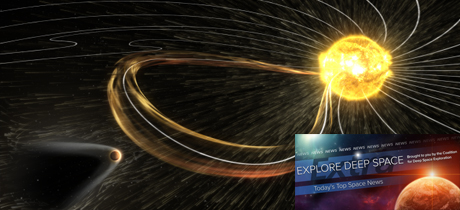In Today’s Deep Space Extra… U.S. and Australia sign long-term space cooperation agreement; the sun may electrify Martian moons; and the James Webb telescope budget stays on track.
Human Space Flight
Australia, U.S. sign up to new space exploration treaty
ITwire.com (10/18): A new treaty signed this week cements a long running partnership between the U.S. and Australia in space operations. The agreement allows NASA owned communications and tracking facilities to operate on Australian soil in support of a range of human and robotic missions.
How fit will astronauts be after years in space?
Space.com (10/18): Aboard NASA’s Orion crew capsule, maintaining the physical health of astronauts will be crucial to the success of their long duration missions to deep space destinations.
Sun could electrify Martian moons, affecting both human and robotic missions
EurekAlert! (10/18): Powerful solar eruptions could electrically charge areas of the Martian moon Phobos to hundreds of volts, presenting a complex electrical environment that could possibly affect sensitive electronics carried by future robotic explorers, according to a new NASA study.
Space Science
Meltwater from glaciers may have flowed on ancient Mars
Seeker.com (10/17): Perhaps ancient Mars was not always wet and warm. It may have harbored surface ice that periodically thawed allowing the flow to shape a topography that seems to support the past presence of running water and bodies of water. Brown University researchers published their findings in the journal Icarus.
Metal-eating bacteria could have left their “fingerprints” on Mars, proving it once hosted life
Universe Today (10/18): Look to the red sands of Mars for past evidence of microorganisms that could have thrived in more hospitable warmer and wetter surroundings 3.7 billion years ago. These would have included bacteria at home on soil borne metals, like iron, sulfur and perhaps uranium. European researchers published their findings in the journal Frontiers of Microbiology.
Budget reserves will prevent JWST cost overrun
Spacepolicyonline.com (10/18): Recently, NASA announced that the much anticipated launch of the James Webb Space Telescope will be delayed from late 2018 until late March to late June of 2019. In a report to NASA’s Astrophysics Advisory Committee on Wednesday, a program official said the cost of the delay can be covered without impacting other NASA astrophysics missions.
U.S. detector flaw will delay Europe’s Euclid telescope
Subscription required
Aviation Week (10/18): A flaw in a U.S. furnished detection device on the European Euclid science mission is prompting a launch delay in efforts to further characterize the expansion rate of the universe. The launch targeted for 2020 faces a 12 month delay. The flaw was disclosed during a web cast session of NASA’s Astrophysics Advisory Committee.
Other News
Lego is selling a ‘Women of NASA’ set featuring 4 female scientists, engineers, and astronauts
Business Insider (10/18): Ready for sale on November 1, a new Women of NASA set from Lego highlights astronauts Sally Ride and Mae Jemison, astronomer Nancy Grace Roman, and computer scientist Margaret Hamilton with Lego figures and backdrops.
The year’s 10 most incredible aerospace inventions
Coalition Member in the News (Boeing)
Popular Science (10/17): The list is topped by Boeing’s space suit, which is stylishly designed for safety, flexibility and dexterity. The blue garment is what astronauts with seats aboard Boeing’s CST-100 Starliner will don to launch and descend from the International Space Station. Boeing is partnered with NASA under the Commercial Crew Program to develop the Starliner.
These giant printers are meant to make rockets
Bloomberg (10/18): In a small factory a couple of miles from Los Angeles International Airport, Ellis and Noone have spent the past two years working to build a rocket using only 3-D printers. Their startup, Relativity Space Inc., is betting that removing humans from the manufacturing equation will make rockets way cheaper and faster to produce.
Google Maps expands its interplanetary domain all the way out to Pluto
GeekWire.com (10/18): Google Maps expands to the planets, moons, even the International Space Station, with 3-D imagery accessible with a computer. There’s Io, the volcanic moon of Jupiter; Enceladus, the moon of Saturn with geyser like eruptions; and distant Pluto to explore.
Orionid meteors max out Sunday, Zodiacal light returns
Sky and Telescope (10/18): The Orionid meteor shower fires up this week as the Earth sails through the debris from the Comet Halley.

